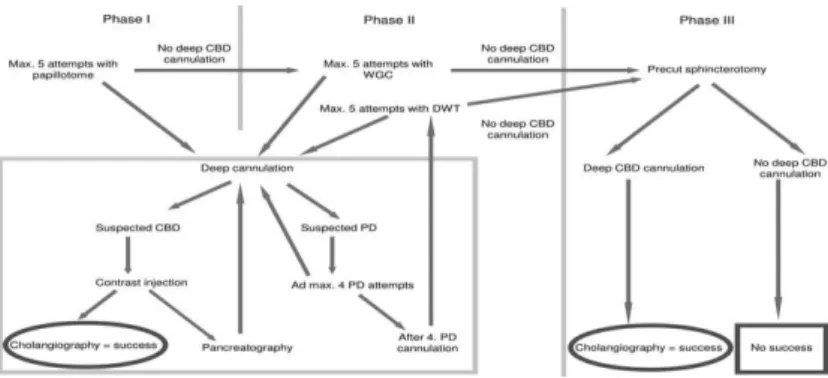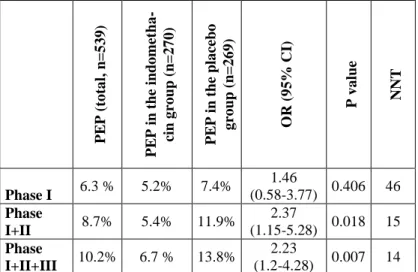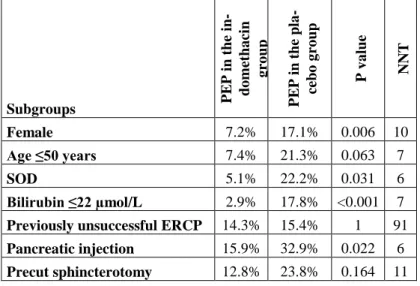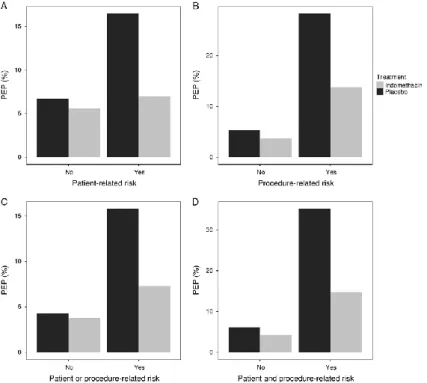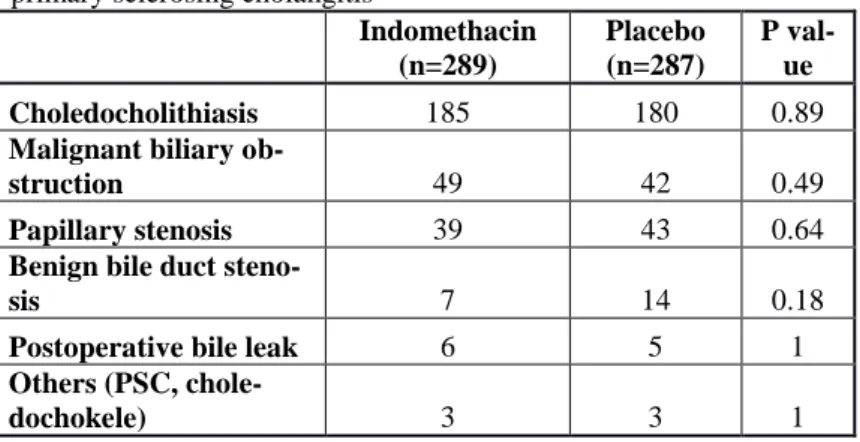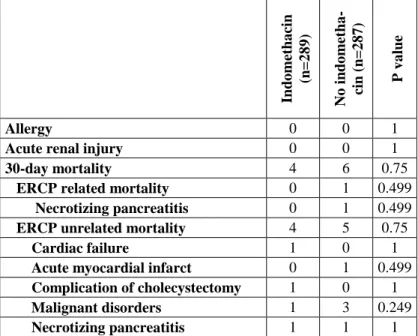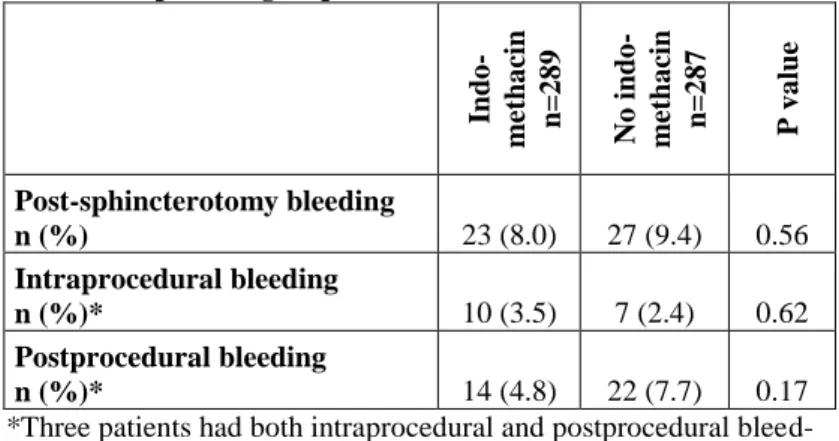ROLE OF INDOMETACIN IN PREVENTION OF ENDO- SCOPIC RETROGRADE CHOLANGIO-
PANCREATOGRAPHY-RELATED PANCREATITIS
PhD thesis
Árpád Patai MD
Doctoral School of Clinical Medicine Semmelweis University
Supervisor: László Herszényi, MD, PhD, DSc Official reviewers: László Czakó MD, PhD, DSc
Gábor Veres MD, PhD, DSc
Head of Final Examination Commitee:
Ferenc Szalay, MD, PhD, DSc Members of Final Examination Commitee:
Péter László Lakatos MD, PhD, DSc András Taller MD, PhD
Budapest 2015
1
ROLE OF INDOMETHACIN IN PREVENTION OF ENDO- SCOPIC RETROGRADE CHOLANGIOPANCREATOG-
RAPHY-RELATED PANCREATITIS
1. INTRODUCTION
The pancreatitis has remained the most frequent and the most serious complication of endoscopic retrograde cholangiopan- creatography (ERCP). Definition of post-ERCP pancreatitis (PEP) is based on a consensus workshop in 1991: (1) new or worsened pan- creatitis-type abdominal pain, (2) serum amylase (or lipase) 3 times or more the upper limit of normal measured more than 24 hours after the procedure and (3) need for hospitalization at least 2 days.
This diagnosis of pancreatitis has been completed by contrast- enhanced computed tomography (CECT) and / or magnetic reso- nance imaging (MRI) of the pancreas.
Independent risk factors of PEP are divided into two groups: patient-related and procedure-related groups. The definite patient-related risk factors are suspected Oddi sphincter-dyskinesis, female gender, previous pancreatitis. The definite procedure-related risk factors are pancreatic guidewire passages >1, pancreatic injec- tion. Likely risk factors are previous PEP, younger age, nondilated extrahepatic bile ducts, absence of chronic pancreatitis, absence of bile duct stone, normal serum bilirubin, high number of cannulation attempts, acinarization, precut sphincterotomy, pancreatic sphincter- otomy, low ERCP volume, biliary balloon dilation of sphincter, failure to clear bile duct stones, intraductal ultrasonography.
2
Since the exact mechanism of PEP is not well known, a com- plex strategy has to be applied for prevention of PEP. This strategy consists of careful consideration of indications, well-hydration with early aggressive intravenous fluid intake (that means 250-500 mL/h Ringer-lactate within the first 6 hours), use of papillotome substitut- ing standard ERCP catheter, use of wire-guided cannulation, limita- tion of attempts for cannulation and early precut, placement of a short, 5-Fr diameter pancreatic stent in high-risk patients. A lot of pharmacological agents have been studied, recently the efficacy of glyceryl trinitrate and two nonsteroidal anti-inflammatory drugs (NSAIDs) (diclofenac and indomethacin 100 mg rectally) have been accepted. Pure-cut current was thought to cause less PEP because, it results in less edema than blended current, but a meta-analysis proved that pure-cut current does not have advantage over blended current for prevention of PEP.
The indomethacin is a potent inhibitor of phospholipase A2, cyclooxygenase (COX), and neutrophil-endothelial interactions, therefore it is able to interrupt the initiation of inflammatory cascade in PEP. Some authors found indomethacin effective in the preven- tion of PEP, but other publications could not prove this prophylactic effect and others drew attention to risk of gastrointestinal bleeding and cardiovascular hazard stemming from its COX-2-inhibitoring effect.
2. AIMS
My primary aims were to estimate the efficacy of rectally ad- ministered indomethacin for prevention of PEP, especially in differ- ent patient-related and procedure-related risks and secondly to asses
3
side effects of indomethacin particularly bleeding after biliary sphincterotomy (BABES) and cardiovascular mortality.
3. METHODS 3.1. Patients
ERCP with proposed biliary therapy was performed in unse- lected, consecutive in-hospital patients with naïve papilla following routine admission history and physical examination, abdominal ul- trasonography, and laboratory tests. Exclusion criteria were age under 18 years, presence of acute pancreatitis, pregnancy or lacta- tion, upper gastrointestinal obstruction, history of Billroth II or Roux-en-Y anastomosis, history of allergy to indomethacin or con- trast medium, serum creatinine level >125 µmol/L (1.41 mg/dL), INR >1.5, platelet count <50x109/L, the use of NSAIDs within 1 week before admission, and refusal to participate in the study. Aspi- rin and clopidogrel were stopped 1 week before ERCP, if it was not contraindicated, but 100 mg aspirin and 75 mg clopidogrel was not the cause for exclusion. Patients with cannulation of the minor papil- la, previous severe PEP, or papillectomy were excluded; in these cases insertion of prophylactic pancreatic stent was performed. All patients gave written informed consent before enrollment.
In trial ’A’ 574 patients with intact papilla proposed for a bil- iary endoscopic therapy at the 1st Department of Medicine and Gas- troenterology, Sopron Elizabeth Teaching Hospital were included into a randomized, prospective, double-blind clinical trial to study the effect of rectally administered 100 mg indomethacin for the pre- vention of PEP. This study was conducted in accordance with the
4
Declaration of Helsinki and the ICH Guidelines for Good Clinical Practice. The protocol was approved by the medical ethics commit- tee of Sopron Elisabeth Teaching Hospital. A sequential protocol including early precut was applied for cannulating the common bile duct to avoid prolonged and unsuccessful attempts. Treatment allo- cation and concealment were conducted in a blinded manner by an independent pharmacy staff in a separate building preparing supposi- tories of identical appearance that contained either 100 mg indo- methacin or placebo.
Trial ’B’ was a ’post hoc’ analysis of post-sphincterotomy bleeding and cardiovascular mortality using prospectively collected clinical trial data of patients treated with 100 mg indomethacin or placebo for prevention of PEP. 576 patients of trial ’B’ were recruit- ed from previous study excluding patients without endoscopy sphincterotomy but including patients examined by ERCP in this period due to acute biliary pancreatitis.
BABES was divided into two categories: intraprocedural and postprocedural bleeding. Intraprocedural bleeding in cases when hemostasis (electrocoagulation or injection of epinephrine) was nec- essary during ERCP. This procedure was indicated two situations:
hemorrhage was intensive according to my judgment, or bleeding did not stop 3 min after endoscopic sphincterotomy (EST) or the last endoscopic maneuver. Postprocedural bleeding was defined in pa- tients with clinical signs of bleeding or if the decrease of hemoglobin level was greater than 20 g/L within 24 hours after completion of EST and subsequent upper gastrointestinal endoscopy did not show other source of bleeding.
5
3.2 ERCP
A preconceived protocol (Figure 1) was applied for cannula- tion of common bile duct, number of cannulation attempts was re- stricted.
Figure 1. Protocol for cannulation of common bile duct. CBD:
common bile duct. PD: pancreatic duct. WGC wire guided cannula- tion
At first, 5 trials were allowed with papillotome to reach deep cannulation of bile duct (phase I). After deep cannulation of one of the biliary or pancreatic duct, it was filled with contrast material. If cholangiography was achieved, ERCP was evaluated to be success- ful. If the pancreatic duct was opacified, acinarization was avoided.
After 5 unsuccessful attempts, a hydrophilic guidewire was in- troduced to help cannulation or double-wire technique was applied after 4 pancreatic duct cannulations (phase II). When deep biliary cannulation was not achieved during 5 wire guided cannulations, one of the following precut techniques was performed (phase III) injec- tion.
6
If the guidewire was in the pancreatic duct, transpancreatic sphincterotomy was performed; if the papillotome was in the papilla but not deep enough, a precut was made with the same papillotome;
finally, if the orifice could not be cannulated, a needle-knife papil- lotomy was performed. Contrast injection before achieving deep ductal cannulation was not allowed to prevent papillary submucosal depot.
3.3. Statistical analysis
Sample size of study ’A’ was estimated based on our previous experience that the incidence of PEP was 10% and according to a previous meta-analysis indomethacin decreased the incidence to 64%. With a type I error of 5% and a power of 80%, a total of 273 patients needed to be included in each treatment arm. We calculated with additional 5% of patients (273x1.05=287), who would be ex- cluded after randomization. For the univariate analysis of outcome (PEP), 2-tailed Fisher’s exact test was used. Student’s t-test was used to compare groups with continuous variables. Multivariate analysis was performed by logistic regression. All statistical analyses were performed by using the R-environment. In both trials (’A’ and ’B’) a P-value of <0.05 was considered significant.
4. RESULTS 4.1. Results of study ‘A’
539 patients with proposed biliary endoscopic therapy were analyzed in this study (270 patients in the indomethacin group, 269 patients in the placebo group). Pure diagnostic ERCP was performed
7
in 16 patients (3%). Each patient was followed up for at least 30 days.
There was no difference in demographical or clinical charac- teristics and endoscopic procedures and outcome between patients in the indomethacin or the placebo groups. There was no significant difference in rates of the successful cannulation in phase I 70.7% vs.
69.9%, in phase II 82.6% vs. 84.4%, in phase III 98.5% vs. 97.8%
between the indomethacin and the placebo groups, respectively.
Table 1. Effect of indomethacin on PEP in subsequent cannula- tion phases. PEP: post-ERCP pancreatitis, OR: odds ratio, CI: con- fidence interval, NNT: number needed to treat. Phase I: 5 attempts of biliary intubation with papillotome. Phase II: 5 attempts of biliary intubation assisted by guide wire or 5 attempts with double wire technique. Phase III: precut.
groups.
PEP (total, n=539) PEP in the indometha- cin group (n=270) PEP in the placebo group (n=269) OR (95% CI) P value NNT
Phase I 6.3 % 5.2% 7.4% 1.46
(0.58-3.77) 0.406 46 Phase
I+II 8.7% 5.4% 11.9% 2.37
(1.15-5.28) 0.018 15 Phase
I+II+III 10.2% 6.7 % 13.8% 2.23
(1.2-4.28) 0.007 14
8
Our results (Table 1) proved that rectally administered 100 mg indomethacin to be effective in prevention of PEP. PEP rate decreased from 13.8% in the placebo group to 6.7% in the indometh- acin group, number needed to treat (NNT) was 14.
In atraumatic phase I there was no significant difference in PEP rate between the indomethacin and the placebo groups. If intu- bation was not successful in phase I., but the common bile duct was cannulated with subsequent attempts assisted by guide wire, the difference in PEP rate was significant (P=0.018), NNT was 15.
Table 2. Effect of indomethacin on PEP in high-risk subgroups of patients undergoing ERCP. PEP: post-ERCP pancreatitis. NNT:
number needed to treat. SOD: suspected sphincter of Oddi dysfunc- tion
Subgroups PEP in the in- domethacin group PEP in the pla- cebo group P value NNT
Female 7.2% 17.1% 0.006 10
Age ≤50 years 7.4% 21.3% 0.063 7
SOD 5.1% 22.2% 0.031 6
Bilirubin ≤22 µmol/L 2.9% 17.8% <0.001 7 Previously unsuccessful ERCP 14.3% 15.4% 1 91 Pancreatic injection 15.9% 32.9% 0.022 6 Precut sphincterotomy 12.8% 23.8% 0.164 11
9
Our subgroup analysis (Table 2) of high-risk patients showed great benefit of indomethacin particularly in females, in SOD and in patients with normal bilirubin and pancreatic injection.
Figure 2. Effect of indomethacin for PEP in patients with pa- tient- and procedure- related definite risk factors. A, With the absence (P = 1) or presence (P = 0.004) of patient-related definite risk factors. B, With the absence (P = 0.61) or presence (P = 0.028) of procedure related definite risk factors. C, With the absence (P=1) or presence (P = 0.007) of at least 1 patient-related or procedure- related definite risk factor. D, With the absence (P = 0.504) or pres- ence (P = 0.009) of at least 1 patient-related and at least 1 procedure- related definite risk factor. PEP post-ERCP pancreatitis.
10
Analysis of groups with patient-related and procedure- related risk factors is demonstrated in Figure 2. Indomethacin was not effective in patients with the absence of patient-related definite risk (Figure 2. A) and with the absence of procedure-related definite risk (Figure 2. B). Indomethacin decreased the freqency of PEP significantly in patients with the presence of at least one patient- related definite risk factor (P=0.004) (Figure 2. A), with the pres- ence of at least one procedure-related definite risk factor (P=0.028) (Figure 2. B), with the presence of at least one procedure-or patient- related definite risk factor (P=0.007) (Figure 2. C), with the pres- ence of at least one patient related and procedure related risk defi- nite factor (P=0.009) (Figure 2. D).
4.2. Results of study ‘B’
576 patients were analyzed in ‘B’ study (289 patients in the indomethacin group, 287 patients in the placebo group). There were 87 patients using acetylsalicylic acid (ASA), 29 patients using clopidogrel.
Table 3. Indications of biliary endoscopic sphincterotomy. PSC:
primary sclerosing cholangitis
Indomethacin (n=289)
Placebo (n=287)
P val- ue
Choledocholithiasis 185 180 0.89
Malignant biliary ob-
struction 49 42 0.49
Papillary stenosis 39 43 0.64
Benign bile duct steno-
sis 7 14 0.18
Postoperative bile leak 6 5 1
Others (PSC, chole-
dochokele) 3 3 1
11
There was no difference in demographical data or clinical characteristics, endoscopic procedures and outcome between patients of the indomethacin or the placebo groups. The indications of EST were similar in the indomethacin and in the control groups (Table 3).
Table 4. Adverse events, mortality (except of bleeding). ERCP:
endoscopic retrograde cholangiopancretography
Indomethacin (n=289) No indometha- cin (n=287) P value
Allergy 0 0 1
Acute renal injury 0 0 1
30-day mortality 4 6 0.75
ERCP related mortality 0 1 0.499
Necrotizing pancreatitis 0 1 0.499
ERCP unrelated mortality 4 5 0.75
Cardiac failure 1 0 1
Acute myocardial infarct 0 1 0.499 Complication of cholecystectomy 1 0 1
Malignant disorders 1 3 0.249
Necrotizing pancreatitis 1 1 1 Complications of endoscopic therapy were similar in the in- domethacin and in the placebo groups (Table 4). We did not noticed allergy, renal failure from indomethacin. Cardiovascular mortality did not differ between the two groups.
12
Table 5. Bleeding after biliary sphincterotomy in the indometha- cin and the placebo groups.
Indo- methacin n=289 No indo- methacin n=287 P value
Post-sphincterotomy bleeding
n (%) 23 (8.0) 27 (9.4) 0.56
Intraprocedural bleeding
n (%)* 10 (3.5) 7 (2.4) 0.62
Postprocedural bleeding
n (%)* 14 (4.8) 22 (7.7) 0.17
*Three patients had both intraprocedural and postprocedural bleed- ing
The rate of BABES was similar in the indomethacin and in the placebo groups (Table 5) and it was not influenced by ASA and/or clopidogrel (Table 6).
Table 6. Multivariate analysis identifying risk facrors for bleed- ing after biliary sphincterotomy. CI: Confidence interval. OR:
Odds ratio
OR 95% CI P
Age >50 years 1.52 0.67, 3.42 0.32
Sex, female 1.36 0.71, 2.60 0.36
Precut 0.98 0.43, 2.17 0.95
Lithotripsy 1.06 0.30, 3.70 0.93
Biliary stent implantation 0.94 0.48, 1.86 0.86
Indomethacin 0.83 0.46, 1.49 0.53
Acetylsalicylic acid 1.20 0.55, 2.64 0.64
Clopidogrel 0.72 0.16, 3.14 0.66
5. CONCLUSIONS
Our prospective randomized study confirmed that rectally administered 100 mg indomethacin decreased the rate of PEP from
13
13.8% to 6.7 % (p=0.007), when the common bile duct was intubat- ed according to our cannulation protocol limiting number of attempts and applying early precut. This prophylactic effect of indomethacin is very strong in patients with patient- and procedure-related risk factors.
Results of our prospective study indicate that single dose of indomethacin did not increase short-term cardiovascular mortality and this result is similar in APA takers and non-APA takers. Moreo- ver, we provided evidence that the use of indomethacin for the pre- vention of PEP has no impact on the rates of intraprocedural and postprocedural bleeding following biliary sphincterotomy.
REFERENCES
1. Patai Á, Solymosi N, Patai ÁV. (2014) Does rectal indomethacin given for prevention of post-ERCP pancreatitis increase bleeding after biliary endoscopic sphincterotomy or cardiovascular mortality?
Post hoc analysis using prospective clinical trial data. Medicine, 93:
pe 159. IF:4.867
2. Patai Á, Solymosi N, Patai ÁV. (2015) Effect of rectal indometh- acin for preventing post-ERCP pancreatitis depends on difficulties of cannulation. Results from a randomized study with sequential biliary intubation. J Clin Gastroenterol, 49: 429-437. IF:3.186
3. Patai Á, Solymosi N, Mohácsi L. Patai ÁV. (2015) Prevention of ERCP-related pancreatitis. World J Gastroenterol, [Submitted]
IF:2.433
4. Patai Á, Patai ÁV, Solymosi N, Tulassay Z, Herszényi L. (2015) Az endoszkópos retrográd cholangiopancreatographiát követő he- veny hasnyálmirigy-gyulladás megelőzése. Orv Hetil, 156: 711-715.
